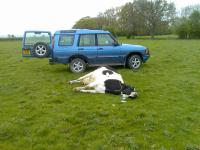
I was called out to Farmer J on Tuesday evening who is running a dairy herd. On the phone the farmer told me he had a poorly cow.
Arriving on farm there was a cow frantically licking the wall and the ground. She was absolutely fine that morning in the parlour and started her strange “licking” behaviour in the afternoon.
For examination we run her into a race where she started wildly pressing forwards and biting the gate.
Overall examination (as far as was possible given her behaviour), she had high fever, 104.5F, 40.3C, her rumen wasn’t working and her faeces were very soft. Except this and the neurological signs, no other clinical signs were observed.
The cow wasn’t sensitive to touch but the gate biting became worse and she started to bite anything in her way, even trying to bite the air.
Suspected prognosis was an infection that had gone through the blood/brain barrier, or some infection combined with nervous acetonemia.
Nervous Acetonemia is an intoxication by circulating ketone bodies. This is caused by energy deficiency.
Signs of simple but already clinical ketosis are cows off feed and lethargy, hence also called “slow fever”.
In ketosis cases that have become worse, cows can show severe nervous signs like compulsive licking, salivation, biting flanks (or anything in their way as in this case) up to manic behaviour.
Not to forget that in case you have cows showing signs of simple ketosis post calving, there might a few more cows with subclinical ketosis.
Subclinical ketosis, which is dietary in origin, is becoming more and more of a problem in dairy herds. It can cause (or be caused by milk fever), retained placenta or even LDA’s (stomach displacement)
There are many ways to check cows for ketosis: in milk, urine or blood (which we tend to do at the practice.
The treatment in the above case consisted of antibiotics, due to the high fever, glucose and steroids for ketosis.
The cow was back to normal the following day.

